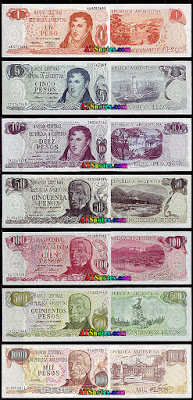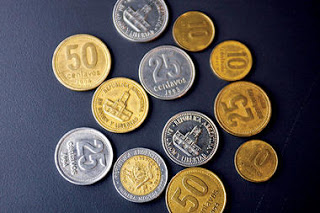This page may contain affiliate links from our advertising partners for which we many receive compensation. This may impact how and where products appear on this site. This site does not review or include all companies or all available products. We are thankful when you support this site by using our links.
This is a guest post written by Won’t Run For Miles! Muchas Gracias!!
I haven’t traveled as much as my counterpart WillRunforMiles. Therefore, I don’t know all the nuances of travel yet. But one thing I DO know. When I AM in a country with different currency, the almighty American Dollar always seems to be greeted with open arms. However, that didn’t seem to be the case when I recently accompanied my fiancé to the beautiful country of Argentina. In fact, the 1 peso coin (which is the basis of this article) didn’t even seem to exist.
When I was packing for my trip, the last thing that I was thinking about was exchanging American money. In the back of my mind, I was probably thinking to myself, “No problem dude. Just take some American money with you and they’ll (meaning the country) gladly accept it”.
So, before heading to the airport, I went to my local bank and changed $100 USD’s. I asked for 50 dollars in one-dollar bills and ten 5-dollar bills. I learned from my last trip (to Mexico), that having small bills is the way to go for tipping and especially greasing the palms of many a local. Of course, I also brought along a few credit cards that didn’t charge any foreign transaction fees along with my ATM card (You see, Will Run For Miles, I actually listened to a few things you’ve said!).
When we first arrived in Argentina, we were in the beautiful area of Mendoza. We decided to hire a guide to show us around the wine country. While in his company, he explained to us what had transpired recently with the currency rate. As usual, I spaced out to the nuances of the conversation. And why I did I space out? Because our guide was MORE than happy to take our American dollars for services rendered. So, the problem at this point for me; was trying to think in pesos rather than dollars. For example, when I saw the sign next to a candy bar saying $10, that it didn’t mean ten USD for purchasing it. Wow, I never used my fingers so much for converting.
The problem of money really didn’t transpire until we left Mendoza and headed to Buenos Aires.
At this point, I had to finally learn that Argentina’s paper money comes in denominations of two, five, 10, 20, 50 and 100 pesos By the way, during our whole stay in Argentina, I never saw a two peso dollar. They seem to be a rare as hen’s teeth. In coins, one peso equals 100 centavos. Coins come in denominations of one (rare), five, 10, 25 and 50 centavos, and one peso. As of this writing, they have a 2 peso coin.
To avoid the hassle of exchanging money, we decided to go to the Citibank ATM machines to get pesos. We decided that exchanging USD’s for Argentina paper money at the bank seemed to be the best way not to get counterfeit money. Banks do rip you off rate wise. As I mentioned before, we were told that local exchange places give a better rate, but was too chancy to try.
FYI, counterfeiting, of both local and US bills, has become a problem in recent years in Argentina. Legit merchants are very careful when accepting large denominations. We learned to look for a clear watermark or running thread on the largest bills. We even took pictures of the serial numbers before giving them to anyone in the event that we were handed back our money saying it wasn’t good.
Changing large denomination bills is a huge problem throughout the country (and a major gripe for Argentines and tourists alike). We were told to change our AR$100 and AR$50 bills to smaller bill denominations to avoid problems. Bait and switching of large bills is commonplace with taxi drivers and a must to avoid.
The funny part of this story is getting coins. (Especially the 1 peso coin).
We decided to use the bus as our means for transportation during our stay. In retrospect, this was a great way to travel around. We were able to avoid taxi costs and problems. In addition, we were able to travel with the common person to see the areas of the city. However, it was nearly impossible to get any coins for the bus.
The fare to travel on public buses in Buenos Aires is 2 pesos, but the buses are not yet equipped to accept the new 2 peso coin. Rather, the buses require coins of 1 peso or less.
“Hola Senor. ¿Tiene cambio para pesos de monedas?” meaning, “Do you have change?” The answer would always be “No.”
How we were able to get coins for the bus until we went to the bank is beyond me. The hotel didn’t have any. The person on the street didn’t have any. What’s a tourist to do?!
When we went on the bus, I messed up by putting all the coins into the machine at once. This made the machine go nuts. It didn’t register all the coins dropped into the machine leaving me with a deficit of one peso. I asked a person on the bus, “Brother can you spare a peso?” He decided to give us the remaining money to expedite the affirmative demands and interactions between the bus driver and me.
Is there a moral to the story? Maybe. Just be aware that when you’re in Argentina, be ready to do a James Bond scene at the local exchange place if you want the best bang for your buck on the peso. If not, bring a cup with you to beg for coins. “May I have your attention please?”
Please note: Will Run For Miles may have a financial relationship with some of the merchants advertised on the blog, and may receive minimal compensation if consumers utilize the links located on this site and generate sales therefrom.
Editorial Note: The editorial content on this page is not provided by any of the companies mentioned, and has not been reviewed, approved or otherwise endorsed by any of these entities. Opinions expressed here are author's alone.


 A New York frequent flyer who elegantly combines her passions for worldwide travel, running a gazillion marathons all over the globe and staying fit ... without sacrificing her fancy for good wine and food.
A New York frequent flyer who elegantly combines her passions for worldwide travel, running a gazillion marathons all over the globe and staying fit ... without sacrificing her fancy for good wine and food.
Delightful story! Excellent writing. I giggled more than once, all the while taking notes towards the moral of the tale. 🙂